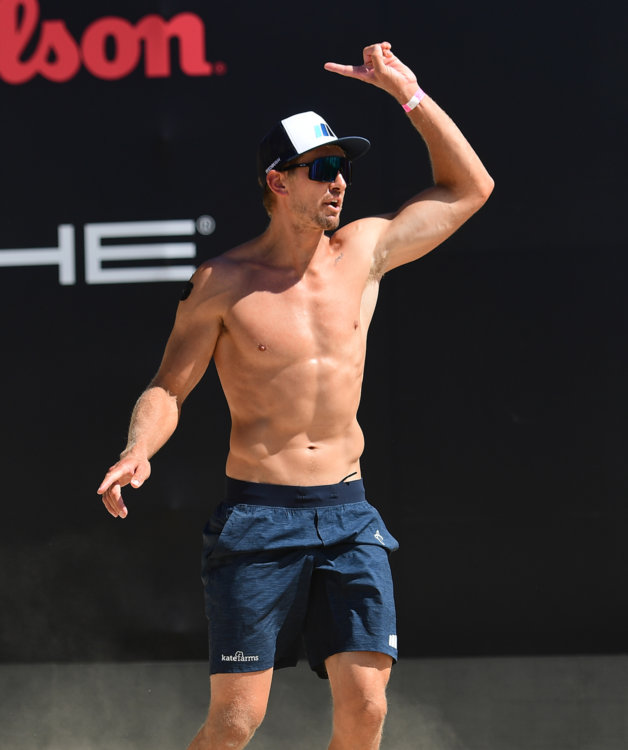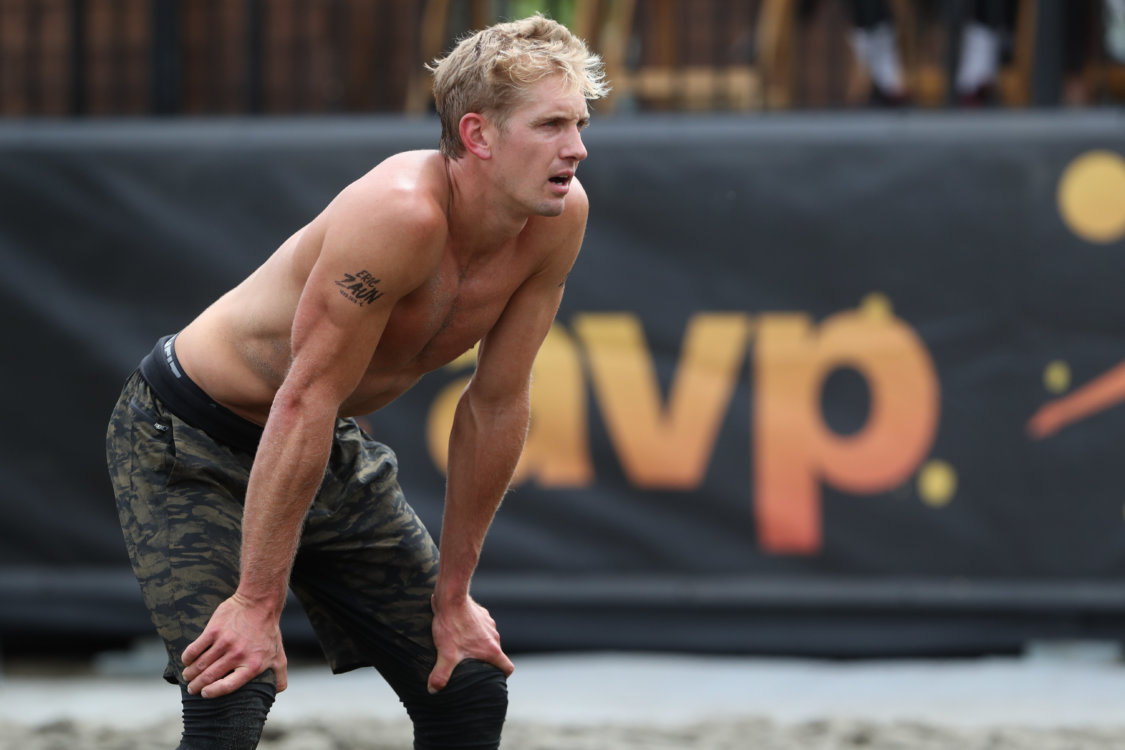I remember a few years ago when Tri was voted Best Offensive player at the AVP Awards Banquet, he stepped up to accept the award and had an authentic look of surprise on his face. It’s pretty standard for people to fake that look, but I could tell Tri was genuinely surprised. He said that he typically thought of himself as a defensively-minded player, so it was cool for him to receive that award in particular. I also voted for him.
I would say that in my beach career, I can relate to the idea of being a naturally defensively-minded player. When I approach a match, the first place my head goes to is scheming how to stop the other team. Where are their weaknesses and what are their tendencies? What is our block/D doing? How are we going to score our “real points?”

At the level we’re playing, I find that it doesn’t do much good to go into a match with the expectation or even the intention to blow the other team away. You might do that every once in a while, but I find it serves you better to go into the game excited to get in a fight with somebody and be willing, almost hopeful, to trade punches until the end. And for me, trust in my sideout game produces the most confidence.
When you believe in your sideout, everything gets easier. You hit your serve with more aggression and make more assertive moves on block/D. More importantly, you let go and move on quicker when the other team puts the ball away because you believe you can sideout with them all day.
Siding out is a delicate balance of having a plan of attack while also letting your instincts take over. I think most players know the feeling of getting into predetermined swings or shots that you are hoping will beat the defense versus the rhythm of seeing and feeling the play develop. Sometimes you feel like the other team is all over you, and you can’t get a sense of where you can get a kill. Other times you might be siding out, but inside you (and ONLY you) know that you are getting a little lucky because you’re not confidently seeing and attacking.
I think many of us also know the feeling of trying TOO hard to see the court or working TOO hard to avoid the block. Sometimes when you are trying so hard to get one step ahead of the other team, at the moment of truth, when it’s time to swing or shoot, you end up unbalanced or lacking solid contact. You make a late indecisive swing low into the block, or you hit a weak shot that your opponent walks to.
The balance of intentionality and instincts is crucial. You have to trust your training and talent to know what to do with the ball at that moment of decision. But you also have to have a solid plan on how you are going to get yourself to the right position to act instinctively. And even more importantly, you have to be able to instantaneously make adjustments to that plan in response to the game.
In every sport, players know the area of the court from where they best score. The same goes for beach volleyball; we all have a preferred spot on the net we want to hit from. That’s where the serve and pass game gets so interesting. It’s your job as an offensive player not to let a serve force you into an undesirable position.

The first step in siding out is always passing the ball well and where YOU want it – not where the defense wants you. You have to recognize where a server is trying to get you, and then retake control of the point with your pass.
Beyond that, you have to be ready to react to a pass that wasn’t what you wanted. I know we all usually pass the ball exactly where we want it. But in those shocking moments where you pass a little off or too wide, you have to decide quickly what your setter’s options are, and then what your best options are. This is where predetermined stuff doesn’t work. If you think that high line is going to be open on the next point for whatever reason, a tough serve and a tough pass can really blow that up – and the next thing you know, you’re rolling high line to a defender who is already transitioning.
Your matchup with another team may make you want to attack from a certain spot on the net. Some players like a matchup with the blocker at the pin, where you can put some stress on them to commit a little earlier and try to seal the line or make a bigger move into the angle. If you’re feeling the block well, you can feel that move and challenge the angle hard, turn back to the line, or have an easier option to challenge high hands. Plus, you have the option to use the block out wide in a lot of different ways you don’t necessarily have in the middle.
 Think about playing Taylor Crabb at the pin – if the blocker gives him angle, he has all the power and range in the world to hit sharp and hard, or just hit right through a defender. But if a blocker gives him a little line – he feels that and can turn back hard or chizzy the block 100 different ways. It’s the blocker’s need to make a somewhat early commitment to something at the pin against an athletic hitter that gives that hitter some solid options.
Think about playing Taylor Crabb at the pin – if the blocker gives him angle, he has all the power and range in the world to hit sharp and hard, or just hit right through a defender. But if a blocker gives him a little line – he feels that and can turn back hard or chizzy the block 100 different ways. It’s the blocker’s need to make a somewhat early commitment to something at the pin against an athletic hitter that gives that hitter some solid options.
Other players like to use the middle of the court to put stress on the defender, challenging them to run one way or another. If you’re seeing the court well, you can take the blocker out of the game a little more and use the sidelines and corners more effectively with shots and chops. Or just bang if the blocker can’t stop it.
From the middle, blockers can make a move one way or the other a little later and take away more court at the last minute, but defenders are having to make decisions earlier if an attacker is seeing things well.
Since we’re talking about Crabbs, let’s use Trevor Crabb as an example. Imagine blocking against him attacking from the middle. Trev is great at using a medium tempo set and he stays behind it really well. As he approaches, you know he has a crisp and fast high line that he can hit anytime. It’s crisp enough that you have to be leaning toward it most of the time to get there on defense, but you also know that his vision is so good that he can see you lean that way and cut sharp to the angle or easily roll over angle to take the block totally out of it. And he can always hit the ball hard to keep you honest.
All this is to say: getting to your spot as an attacker based on the defense is where the pre-planning in your offensive game needs to happen. But that is where it has to end. From there, instinct on where to put the ball needs to kick in.
So many players have wondered over the years, “how do I see the court better?” The answer is different for everybody. Olympic Gold Medalist Todd Rogers used to describe to me how he would pass, look, take his timing step, look again, and then on his step close, he would leave the ball with his eyes all the way and take that famous big look while his arms were in their backswing and then hit his shot.
So many guys tried to imitate him, but honestly, I don’t think it’s for everyone. The way Todd jumped and used his timing, he was able to approach deliberately, still get lift, and keep power in his arm swing. Not everyone jumps that way. Not everyone thrives on taking eyes fully off the ball to see the court. And honestly, most people don’t have the touch Rogers had on his shots. Nick Lucena also does this; he and Todd are not the same player, but Nick is exceptional at taking a full, deliberate look on his step close.
We just talked about Trevor. He’s a good example of using faster tempo in the set (Rogers took a high set straight up and down) to keep the court in front of him the whole time. He doesn’t leave the ball to see. He stays behind the ball and keeps his vision on the court throughout his approach. So he sees the setup and the late move almost through the ball.
Some players see better with a ball that has some travel on it. Jake Gibb has had so much success with his wide high push ball to the pin because it
- Forces the blocker to commit boldly, and
- Lets his eyes track the ball across his body as a right-sider: as he follows the ball, he scans the court.
If you pass and take a look at the initial setup on the court and then get your eyes to your setter and call for a push – as you track the ball, you will naturally see what the defender is doing. And when the ball reaches you, you can also feel the blocker’s move he/she has to make because the wide set creates that pressure. Put it together, and you have ample options.

Here’s the thing – you may find that one day, you can create vision for yourself one way, and the next day might be different. I have seen that many times in my career, and sometimes failed to recognize it in a match. I’ll lose a game and realize I wasn’t seeing the ball and the court well from the pin, and know I never tried to go middle or never tried tempo. Change it up if things aren’t working; we’re looking for confident sideouts. Ones you feel you can do all day.
Of course, a good team may figure you out and adjust. You need to realize and adjust back. Almost always, to compete with a good team, you need to mix up your sideout game. Use different spots, tempos, and option plays to hit different shots.
That’s why it is so important to have a toolbox of shots and swings from different spots on the court. And never stop adding to it. You have to go into practice trying to expand your arsenal. If you do that, then you can let go of the controls in the key moments – and trust your body to know what to do to get the ball to the sand from the spot that is giving you the best look. That kind of instinctual sideout makes you feel confident in a close game. And that’s why the game is so awesome – you can never stop adding to your arsenal, improving your confidence, and learning the science of the sport.